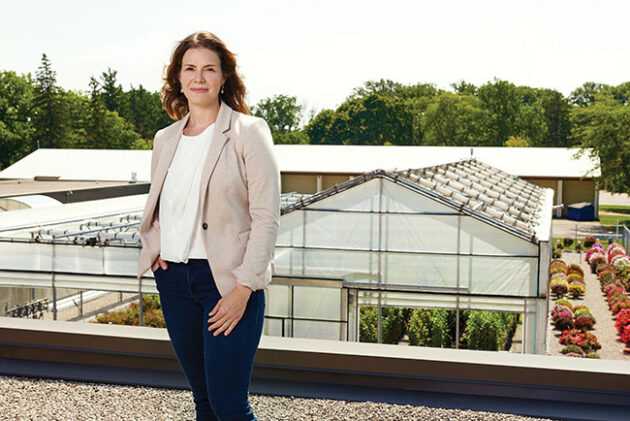
Features
Q&A: A conversation with Vineland’s Darby McGrath
Vineland has named Darby McGrath as its new vice-president of research and development
August 30, 2022 By Andrew Snook
 Darby McGrath has been working at Vineland Research and Innovation Centre for close to a decade as a research scientist and program leader for a variety of projects. Photo: Vineland.
Darby McGrath has been working at Vineland Research and Innovation Centre for close to a decade as a research scientist and program leader for a variety of projects. Photo: Vineland. Vineland Research and Innovation Centre (Vineland) recently appointed Darby McGrath as its vice-president of research and development. In her new role, McGrath will guide the direction of Vineland’s innovation portfolio to maximize real-world impact with a team of more than 50 scientists and technicians.
Greenhouse Canada recently had the opportunity to speak with McGrath and ask her about her current and future goals.
Please start by telling me a little about yourself, your background, and what led you to Vineland?
I’ve been at Vineland for almost 10 years now. I started in 2013, as a research scientist, and worked my way up to a senior research scientist and a program leader. It’s a bit of a mixed bag, I’m a restoration ecologist by training with a focus on sustainability policies – how to implement those things in the real world. And so, when I started 10 years ago, it was really to fill a need on how to properly use green infrastructure in our landscapes, and how to deliver on the growing demand that we’re seeing from both private users and the public sector. So, a lot of my research portfolio has focused on the challenges and opportunities of using plants as living green infrastructure, but also with a significant focus on plant production.
What sparked your interest to take on the role of vice-president of R&D?
Having worked here for as long as I have, I see the impact and benefit from the work that we do at Vineland every day. I see it in the landscape. I see it in greenhouses and nurseries, and on farms. My greatest passion is to watch and mobilize change. It’s not just finding the projects and solutions on the research side, but really focusing on the innovation portfolio that we can deliver to the horticulture sector. And so, when this position came up, I was very excited. We’re at such an important juncture right now for Canadian production systems with respect to things like climate change – and we’re not just looking at adaptation, but mitigation strategies. This research and development role really gives me the chance to think about this innovation portfolio from a strategic perspective. And while I love contributing to it at the research program level, I’m really excited about the chance to hold it all together with this amazing group of scientists.
Do you have any specific projects in mind or specific targets and goals that you want to tackle first?
I don’t think anyone will be surprised by the fact that we really need to be thinking about climate change adaptation, such as technologies that help us towards greater efficiencies in our production systems. Recently, there has been a lot of consideration around supply chain challenges on the food security side, but also on the materials and production sides. We also have to think about climate adaptation from a crop perspective. We need to consider how production systems are going to have to adapt to what we’re facing with climate change. We’re also growing different kinds of crops and different cultivated varieties that allow us to manage those changes and remain competitive in the global marketplace. I think we’re going to really need to dial in on what we can deliver to our stakeholder network in this environment.

McGrath says climate change will change the landscape in terms of which plants will survive. Photo: Vineland.
Do you see yourself working on anything specific to helping the growers with their labour issues, which seem to be constantly increasing?
Yes, absolutely. Where there’s a lot of really solid R&D work already happening is on labour savings and labour efficiency. I think it goes without saying that we will absolutely continue to look at how we can support that through bottom-integrated, automated solutions. So, helping growers actually figure out how to incorporate these things into existing systems such as retrofitting, but also looking for those new and novel ways of automating technologies or processes that will allow us to remain competitive when the labour market is so uncertain.
When it comes to pest management and managing viruses and diseases in various plants, how challenging is that these days? Do you see that changing in the future?
It’s always challenging. Growers have one of the most stressful jobs because of these types of challenges. And you can only control your sphere of influence, which is really your own production system. So, we’re absolutely reliant on getting good information in terms of production systems to be able to forecast those changes. And then ultimately, there’s a significant effort that is required in staying current with the challenges we’re faced with now and how we tackle them. Some of that is going to be the kind of research that we’ve already undertaken.
Climate change will certainly change the landscape in terms of which plants will survive and which pests and diseases we’ll be faced with. This new environment will be more hospitable for some and less hospitable for others. So, we really need to have a good understanding of this situation and remain cognizant of what the global landscape looks like. The solution lies with new technologies that we’re developing now and best practices on how to adapt to those challenges as they continue to evolve.
Print this page